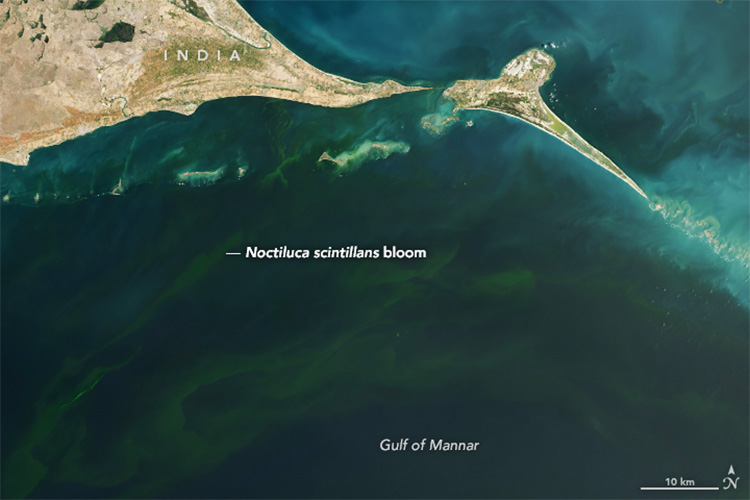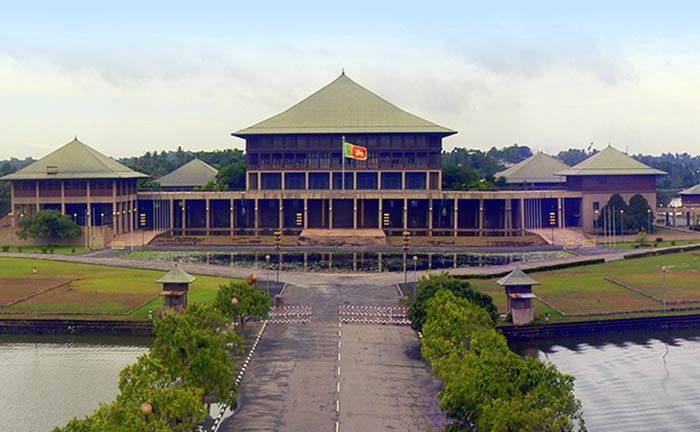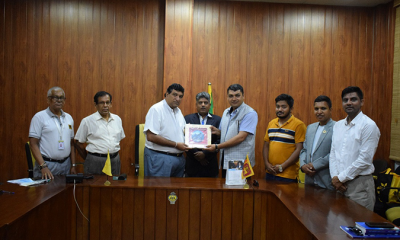News
NASA: Deadly blooms in the Gulf of Mannar

For the past four years, water in the Gulf of Mannar has turned bright green in September and October as the population of a single-celled phytoplankton called Noctiluca scintillans soared. These large blooms of the marine dinoflagellates glow a spectacular shade of blue at night, but their presence can have deadly consequences for marine life by soaking up all the oxygen in the water and causing hypoxia and dead zones, said a report by NASA yesterday.
That’s what was happening on September 23, 2022, when the Operational Land Imager-2 (OLI) on Landsat 9 captured this image of whorls of N. scintillans discoloring waters in northern Sri Lanka and southern India near the Gulf of Mannar Marine Biosphere Reserve. The shallow water in this area normally teems with coral, reef fish, sea turtles, dolphins, dugong, and other marine life. But during N. scintillans outbreaks, fish carcasses line beaches and dead coral skeletons transform reefs.
“We saw particularly severe coral mortality and fish kill in 2019, but it happened in 2021 and 2022 as well,” explained Diraviya Raj, a researcher at the Suganthi Devadason Marine Research Institute in Tamil Nadu, India, and the lead author of a 2020 study about N. scintillans blooms in the Gulf of Mannar. “The 2020 bloom was short and did not harm corals, but the 2021 and 2022 events each lasted for two months, covered large areas, and caused severe damage.”
The earliest reports of N. scintillans blooms causing fish kills in the Gulf of Mannar date back to 1935, with occasional reports of the phenomenon in subsequent decades. However, the regularity and intensity of the blooms since 2019 seem to be something new. “We suspect that climate change has made the N. scintillans bloom an annual occurrence,” Raj said. “The water temperature level has been more than 30°Celsius (86°Fahrenheit) during the blooms, which is unusually high for the Gulf of Mannar in September-October.”
Living staghorn corals are brightly colored, while the dead corals in the photograph above—taken on November 17, 2021, near Manauli Island—had turned white and were covered with algal debris about a month after the bloom started to affect them. Fast-growing corals species such as Acropora, Montipora, and Pocillopora are the most vulnerable to N. scintillans blooms because they require the most oxygen to thrive.
Lines of dead fish, like those shown below, covered beaches on the islands of the Gulf of Mannar and the mainland near Mandapams and Keelakarai when the photo was taken on October 13, 2021. By analyzing water samples, Raj and colleagues confirmed that oxygen-depleted water triggered by the N. scintillans bloom was the cause of the fish kills and coral deaths.
Another team of researchers from the Central Marine Fisheries Research Institute in Mandapam Camp and the Indian Space Research Organization tracking the blooms found that 38 genera of fish were affected by the 2019 bloom and 43 genera by the 2021 bloom. Among them were parrotfish, rabbitfish, pufferfish, lesser sardines, needlefish, and tarpons, they noted in a study published in March 2023.
The 2021 bloom also killed large numbers of animals being raised in finfish farms, explained Ramesh Kumar, the lead author of the study. However, the team thinks it may soon be possible to warn fish farmers of N. scintillans blooms in advance, using improved satellite mapping abilities and new modeling techniques. That may allow farmers to harvest fish before blooms spread to coastal areas and cause widespread damage.
Latest News
Former chief minister of North Central Province, SM Ranjith sentenced to 16 years RI

The Colombo High Court has sentenced former Chief Minister of the North Central Province, S.M. Ranjith and his Private Secretary Shanthi Chandrasena to 16 years of rigorous imprisonment and fined Rs. 200,000 each after they were found guilty of corruption charges.
The Commission to Investigate Allegations of Bribery Or Corruption (CIABOC) had filed the case alleging that the former Chief Minister had illegally obtained Rs. 2,080,500 as fuel allowances during his tenure.
News
Parliament workers on warpath over allowance reductions

Parliamentary staff members are contemplating trade union action in protest against what they describe as a downward revision of their allowances.
The salary revision, as detailed in a circular numbered DMS/Salary Revision/2025-1 (Management Services Circular 04/2025) dated March 25, 2025, has resulted in a reduction of Parliament workers’ allowances, and the decreases which vary, based on staff grades, range from 70% to 39%, raising concerns among Parliament staff, according to sources.
The 32-page circular, addressed to Secretary General of Parliament Kushani Rohanadheera, has been signed by Secretary to the Ministry of Finance, Planning, and Economic Development K. M. Siriwardhana.
Following the announcement of those revisions, parliamentary employees have expressed dissatisfaction, with their unions planning industrial action in the coming days. Sources confirmed that the staff members had already registered their protest with the parliamentary authorities.
The new salary revision has sparked widespread discontent among staff members.
Our attempts to contact General Secretary of Parliament Kushani Rohandheera were not successful.
By Saman Indrajith
News
Japanese funding for project meant to help gender-based violence victims

Japan has funded a project to strengthen Sri Lanka’s commitment to tackling GBV (gender-based violence) and ensuring that survivors were not left without access to critical services.
As part of this project, six more Emergency Waiting Areas (EWAs) will be established in the coming weeks in Dharmapuram (Kilinochchi district), Murunkan (Mannar district), Uppuveli (Trincomalee district), Opanayake (Ratnapura district), Walapane (Nuwara Eliya district), and Modera (Colombo district).
Recently, Japanese ambassador in Colombo Akio Isomata and UNFPA Sri Lanka Representative Kunle Adeniyi, handed over the newly constructed Japan-funded EWA at the Kalutara South Police Station. The Japanese embassy said that this initiative was meant to ensure that survivors received the protection, dignity, and support they deserve when seeking assistance from law enforcement authorities.
The embassy said that there was a growing network of operational EWAs across Sri Lanka, including Jaffna, Mirihana, Pudukuduirippu, Nuwara Eliya, Mundalam, Batticaloa, and Kandy, where over 4000 women and children received support last year. These safe spaces serve as temporary resting areas, providing survivors of GBV with protection, psychosocial support, medical referrals, legal aid, and a survivor-centered approach to justice, the embassy said.
The establishment of the Kalutara South EWA was made possible with the generous funding of USD 34,000, from the People of Japan, and the construction was supported by World Vision Lanka.
Ambassador Isomata reaffirmed Japan’s continued dedication to supporting women and children in Sri Lanka and emphasized the role of safe spaces in ensuring a future free from violence. “Japan has been promoting the protection of women and children in Sri Lanka since Sri Lanka became a partner country for Japan in 2018 in promoting the Women, Peace and Security agenda. This project also includes training for police officers handling victims, especially female officers, so that victims would feel safer in seeking refuge and counseling. I hope this project will be expanded by Sri Lanka’s Ministry of Public Security and Police in order to strengthen the mechanism to protect women and children in vulnerable situations. It is also essential for Sri Lanka to ensure the legal measures against the violence and support for the self-reliance of women and children who seek refuge.”
Speaking at the ceremony, UNFPA Sri Lanka Representative, Kunle Adeniyi, underscored the significance of survivor-centered approaches in addressing GBV. “For a survivor, the decision to seek help is often fraught with fear: fear of judgment, disbelief, or retaliation. When they walk into a police station, they should not only find protection but also compassion and care. A survivor’s first interaction with law enforcement can shape their entire journey toward healing and justice. If they are met with understanding, respect, and support, they are more likely to pursue the help they need.”
-

 Sports3 days ago
Sports3 days agoSri Lanka’s eternal search for the elusive all-rounder
-

 News4 days ago
News4 days agoGnanasara Thera urged to reveal masterminds behind Easter Sunday terror attacks
-

 News2 days ago
News2 days agoBid to include genocide allegation against Sri Lanka in Canada’s school curriculum thwarted
-

 Business5 days ago
Business5 days agoAIA Higher Education Scholarships Programme celebrating 30-year journey
-

 News3 days ago
News3 days agoComBank crowned Global Finance Best SME Bank in Sri Lanka for 3rd successive year
-

 Features3 days ago
Features3 days agoSanctions by The Unpunished
-

 Latest News1 day ago
Latest News1 day agoIPL 2025: Rookies Ashwani and Rickelton lead Mumbai Indians to first win
-

 Features3 days ago
Features3 days agoMore parliamentary giants I was privileged to know























